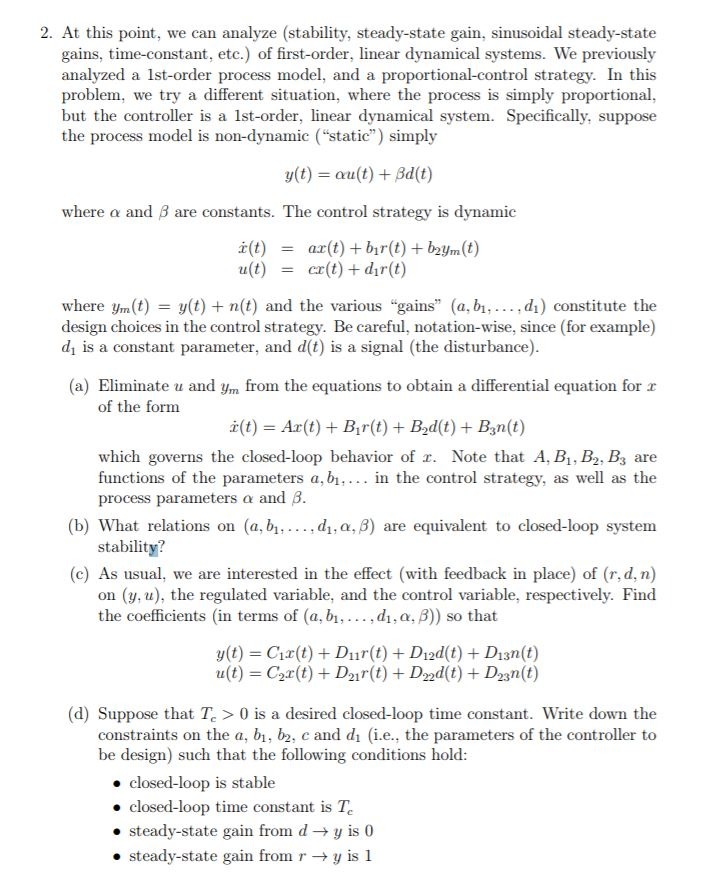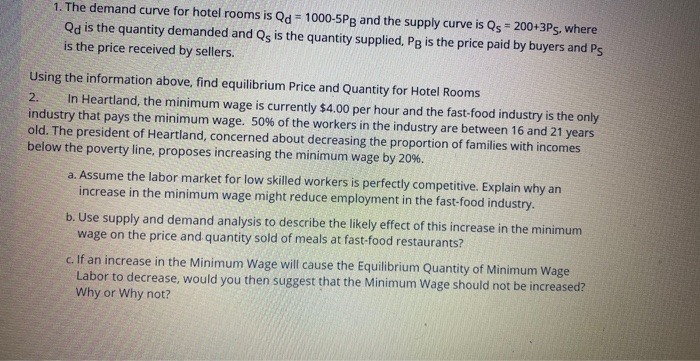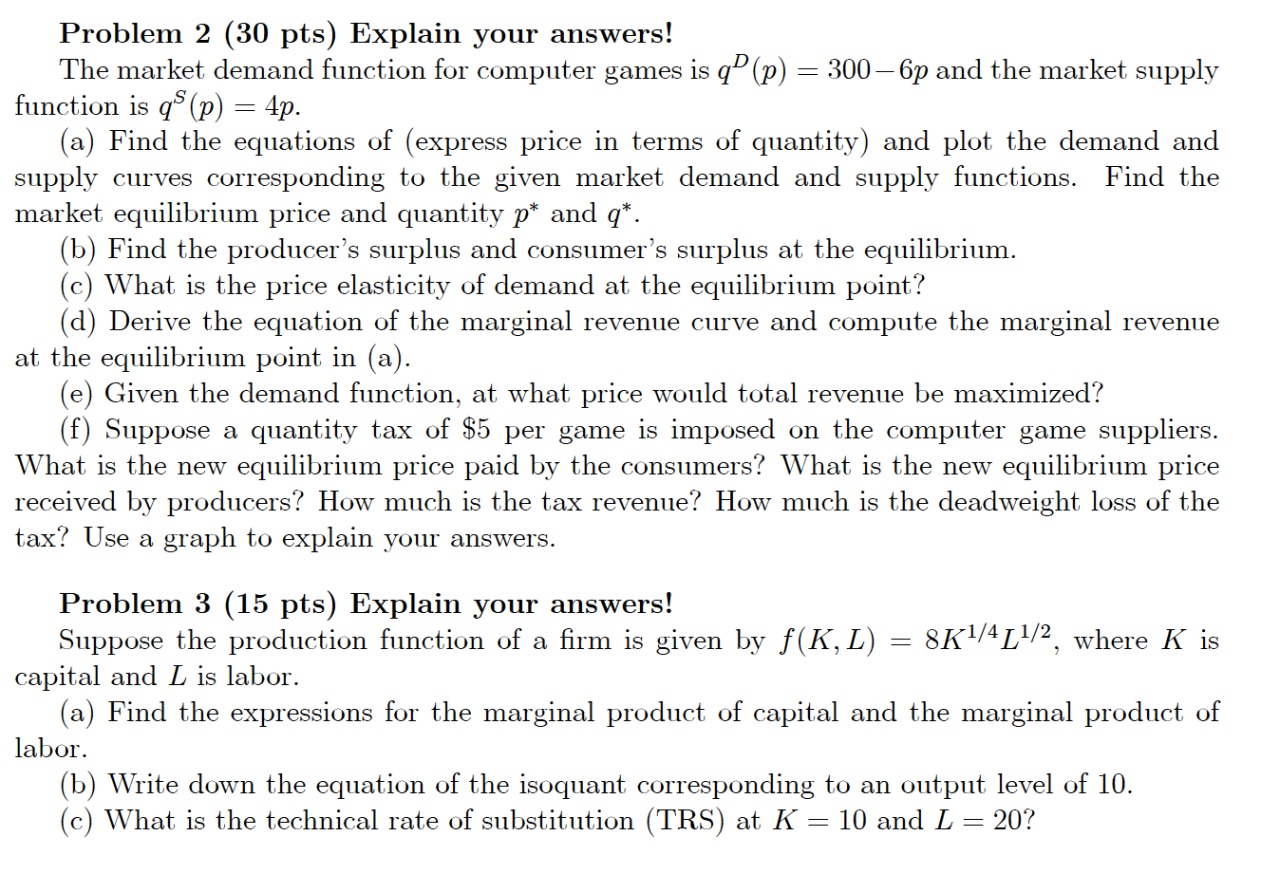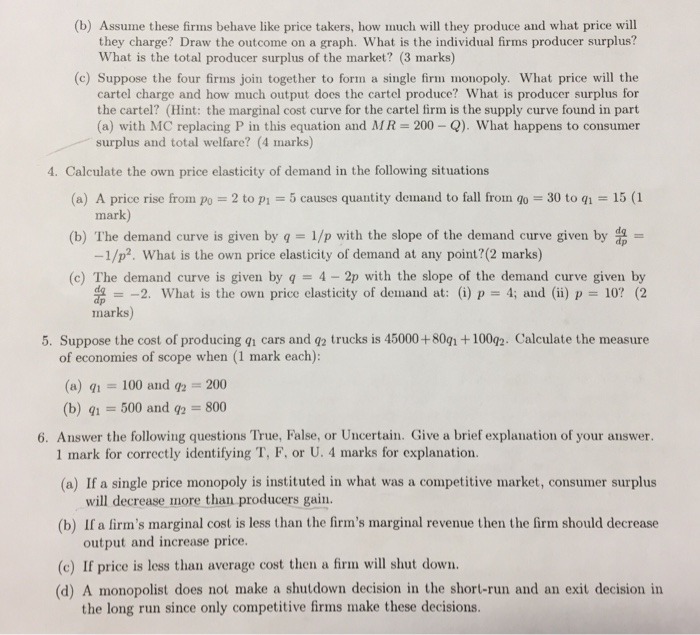



Answer the following questions.
2. At this point, we can analyze (stability, steady-state gain, sinusoidal steady-state gains, time-constant, etc.) of first-order, linear dynamical systems. We previously analyzed a Ist-order process model, and a proportional-control strategy. In this problem, we try a different situation, where the process is simply proportional, but the controller is a Ist-order, linear dynamical system. Specifically, suppose the process model is non-dynamic ("static" ) simply y(t) = cu(t) + Bd(t) where o and B are constants. The control strategy is dynamic i (t) = ar(t) + bir(t) + bzym(t) u(t) = cr(t) + dir(t) where ym(t) = y(t) + n(t) and the various "gains" (a, bi, . .., di) constitute the design choices in the control strategy. Be careful, notation-wise, since (for example) d, is a constant parameter, and d(t) is a signal (the disturbance). (a) Eliminate u and ym from the equations to obtain a differential equation for r of the form r(t) = Ar(t) + Bir(t) + Bad(t) + Ban(t) which governs the closed-loop behavior of r. Note that A, B1, B2, By are functions of the parameters a, b1, ... in the control strategy, as well as the process parameters o and B. (b) What relations on (a, b1. .... dj, or, B) are equivalent to closed-loop system stability? (c) As usual, we are interested in the effect (with feedback in place) of (r, d, n) on (y, u), the regulated variable, and the control variable, respectively. Find the coefficients (in terms of (a, bi, . . ., d1, 0, B)) so that y(t) = Cix(t) + Dur(t) + Died(t) + Dian(t) u(t) = Car(t) + Dar(t) + Dad(t) + Dzan(t) (d) Suppose that T. > 0 is a desired closed-loop time constant. Write down the constraints on the a, b1, b2, c and di (i.e., the parameters of the controller to be design) such that the following conditions hold: . closed-loop is stable . closed-loop time constant is To . steady-state gain from d -> y is 0 . steady-state gain from r - y is 12. At this point, we can analyze (stability, steady-state gain, sinusoidal steady-state gains, time-constant, etc.) of first-order, linear dynamical systems. We previously analyzed a Ist-order process model, and a proportional-control strategy. In this problem, we try a different situation, where the process is simply proportional, but the controller is a Ist-order, linear dynamical system. Specifically, suppose the process model is non-dynamic ("static" ) simply y(t) = cu(t) + Bd(t) where o and B are constants. The control strategy is dynamic i (t) = ar(t) + bir(t) + bzym(t) u(t) = cr(t) + dir(t) where ym(t) = y(t) + n(t) and the various "gains" (a, bi, . .., di) constitute the design choices in the control strategy. Be careful, notation-wise, since (for example) d, is a constant parameter, and d(t) is a signal (the disturbance). (a) Eliminate u and ym from the equations to obtain a differential equation for r of the form r(t) = Ar(t) + Bir(t) + Bad(t) + Ban(t) which governs the closed-loop behavior of r. Note that A, B1, B2, By are functions of the parameters a, b1, ... in the control strategy, as well as the process parameters o and B. (b) What relations on (a, b1. .... dj, or, B) are equivalent to closed-loop system stability? (c) As usual, we are interested in the effect (with feedback in place) of (r, d, n) on (y, u), the regulated variable, and the control variable, respectively. Find the coefficients (in terms of (a, bi, . . ., d1, 0, B)) so that y(t) = Cix(t) + Dur(t) + Died(t) + Dian(t) u(t) = Car(t) + Dar(t) + Dad(t) + Dzan(t) (d) Suppose that T. > 0 is a desired closed-loop time constant. Write down the constraints on the a, b1, b2, c and di (i.e., the parameters of the controller to be design) such that the following conditions hold: . closed-loop is stable . closed-loop time constant is To . steady-state gain from d -> y is 0 . steady-state gain from r - y is 11. The demand curve for hotel rooms is Qd = 1000-5Pp and the supply curve is Qs = 200+3Ps, where Qd is the quantity demanded and Qs is the quantity supplied, Pp is the price paid by buyers and Ps is the price received by sellers. Using the information above, find equilibrium Price and Quantity for Hotel Rooms 2. In Heartland, the minimum wage is currently $4.00 per hour and the fast-food industry is the only industry that pays the minimum wage. 50% of the workers in the industry are between 16 and 21 years old. The president of Heartland, concerned about decreasing the proportion of families with incomes below the poverty line, proposes increasing the minimum wage by 20%. a. Assume the labor market for low skilled workers is perfectly competitive. Explain why an increase in the minimum wage might reduce employment in the fast-food industry. b. Use supply and demand analysis to describe the likely effect of this increase in the minimum wage on the price and quantity sold of meals at fast-food restaurants? c. If an increase in the Minimum Wage will cause the Equilibrium Quantity of Minimum Wage Labor to decrease, would you then suggest that the Minimum Wage should not be increased? Why or Why not?Problem 2 (30 pts) Explain your answers! The market demand function for computer games is qD (p) = BOOSp and the market supply function is qs(p) = 4}). (a) Find the equations of (express price in terms of quantity) and plot the demand and supply curves corresponding to the given market demand and supply functions. Find the market equilibrium price and quantity p* and if". (b) Find the producer's surplus and consumer's surplus at the equilibrium. (c) What is the price elasticity of demand at the equilibrium point? ((1) Derive the equation of the marginal revenue curve and compute the marginal revenue at the equilibrium point in (a). (e) Given the demand function, at what price would total revenue be maximized? (f) Suppose a quantity tax of $5 per game is imposed on the computer game suppliers. What is the new equilibrium price paid by the consumers? What is the new equilibrium price received by producers? How much is the tax revenue? How much is the deadweight loss of the tax? Use a graph to explain your answers. Problem 3 (15 pts) Explain your answers! Suppose the production function of a rm is given by f (K ,L) = SK 1/4111\(b) Assume these firms behave like price takers, how much will they produce and what price will they charge? Draw the outcome on a graph. What is the individual firms producer surplus? What is the total producer surplus of the market? (3 marks) (c) Suppose the four firms join together to form a single firm monopoly. What price will the cartel charge and how much output does the cartel produce? What is producer surplus for the cartel? (Hint: the marginal cost curve for the cartel firm is the supply curve found in part (a) with MC replacing P in this equation and MR = 200 -Q). What happens to consumer surplus and total welfare? (4 marks) 4. Calculate the own price elasticity of demand in the following situations (a) A price rise from po = 2 to p1 = 5 causes quantity demand to fall from go = 30 to q1 = 15 (1 mark) (b) The demand curve is given by q = 1/p with the slope of the demand curve given by $ = -1/p2. What is the own price elasticity of demand at any point?(2 marks) (c) The demand curve is given by q = 4 - 2p with the slope of the demand curve given by dp = -2. What is the own price clasticity of demand at: (i) p = 4; and (ii) p = 10? (2 marks) 5. Suppose the cost of producing q cars and q2 trucks is 45000 +80q1 + 10092. Calculate the measure of economies of scope when (1 mark each): (a) q1 = 100 and q2 = 200 (b) q1 = 500 and q2 = 800 6. Answer the following questions True, False, or Uncertain. Give a brief explanation of your answer. 1 mark for correctly identifying T, F. or U. 4 marks for explanation. (a) If a single price monopoly is instituted in what was a competitive market, consumer surplus will decrease more than producers gain. (b) If a firm's marginal cost is less than the firm's marginal revenue then the firm should decrease output and increase price. (c) If price is less than average cost then a firm will shut down. (d) A monopolist does not make a shutdown decision in the short-run and an exit decision in the long run since only competitive firms make these decisions














